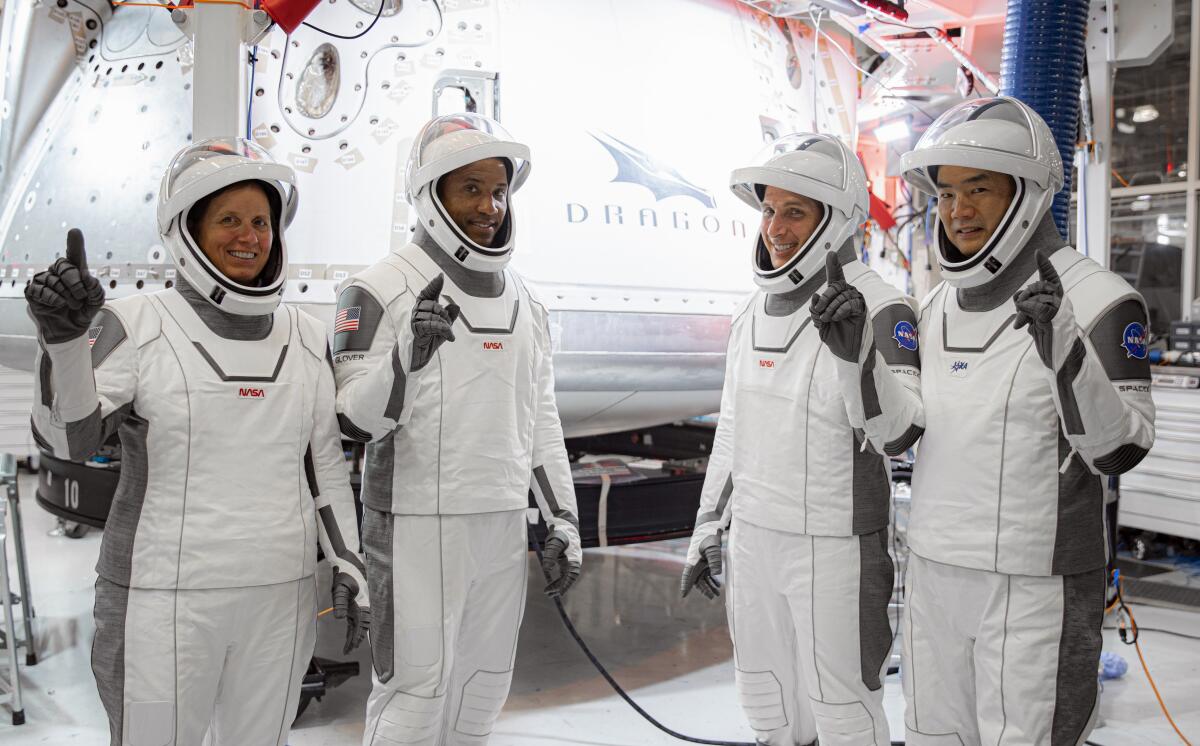This SpaceX launch will open the door to more business in space: ‘It’s a massive market’

- Share via
The first crewed launch was a test — a demonstration mission to prove that SpaceX’s capsule could safely transport NASA astronauts to the International Space Station and back home again.
Sunday‘s launch is supposed to be the start of a new era in spaceflight.
On Sunday, SpaceX’s Crew Dragon craft is set to carry three NASA astronauts and one Japanese astronaut to the space station for a six-month mission. The launch, originally scheduled for Saturday, was delayed until Sunday because of weather.
That flight is intended to be the first of many; this week, NASA certified the Crew Dragon capsule for regular flights to and from the space station, a first for a commercial craft.
That milestone is expected to usher in new and additional commercial opportunities in low-Earth orbit. There are movies to be shot, beauty products to be promoted and tourists to be welcomed to the space station.
How much could all of these opportunities — in fields including medical research — be worth?
“It’s like asking the question in 1995 of how much can the internet be worth,” said Amir Blachman, chief business officer of Houston-based Axiom Space, a company that trains private astronauts and manages their missions to the space station.
“It’s a massive market,” he said, with “billions of dollars of opportunities in the coming decade.”
Already, NASA is making arrangements to accommodate more commercial activities on the space station. Last year the agency laid out a plan that would allow companies and private astronauts to come aboard, for a price.
The space station could also be an appealing destination for countries that have astronauts but lack the capability to launch them into space, just as the United Arab Emirates and South Korea relied on Russia to launch their astronauts in the past. Academic researchers looking to run experiments in microgravity might also be interested.
NASA estimated last year that private astronauts would pay about $58 million for the trip and an additional $35,000 per-day charge while on the station. That revenue could be used to offset NASA’s cost to operate and maintain the U.S. portion of the station, which is about $3 billion to $4 billion a year. That, in turn, could free up funds for other more ambitious missions, such as flights to the moon.
Whether that cost goes down over time will be a key factor in how much commercial activity could increase aboard the space station.
The current price tag of more than $50 million is a high bar, but a $10-million price tag could expand the market, said Laura Forczyk, owner of space consulting firm Astralytical.
Costs could decrease as commercial spacecraft gain more flight experience and make frequent trips to the space station. In addition to SpaceX, Boeing Co. is also developing a crew capsule to ferry NASA astronauts to the station. The aerospace giant has also said it plans to use its capsule to take tourists to space.
Building a track record of safety will be key.
“It’s a balance between expecting that there will be hiccups ... while also hoping we can achieve something that has never been done before, which is more regular, almost routine flights,” Forczyk said. “I’m looking for it to become boring.”
A steady cadence of launches can increase public confidence in crewed missions. SpaceX, for example, has launched 19 times so far this year. Its last major launch setback was in 2016 when a Falcon 9 rocket exploded on the pad, destroying both the rocket and a commercial communications satellite that was supposed to be carried to orbit.
“If you have such a high volume of launches, people just feel more confident in it,” said Marco Caceres, senior space analyst at market analysis firm Teal Group. “It’ll be easier to sell seats when you feel like it’s not going to blow up.”
And there is no shortage of enthusiasm for going to orbit. Blachman said Axiom is speaking with dozens of people interested in flying to space.
“We are seeing a level of excitement and interest about it and practical interest beyond anything you would have expected to see even five years ago,” he said.
Axiom customers were pleased with how “uneventful” SpaceX’s crewed test mission was this summer, Blachman said: It made them feel more comfortable about going on missions of their own.
Axiom said Wednesday that it plans to undertake its first private mission to the space station late next year. The crew, with former NASA astronaut Michael Lopez-Alegria as capsule commander and three private astronauts, will launch in a SpaceX Crew Dragon.
Congress, NASA and other agencies around the world have promised to keep the International Space Station running until at least 2024. Axiom plans to build a commercial space station and have it operational in 2028.
A commercial station could increase the market for in-space activities even further, Caceres said.
If commercial stations come to fruition, “then you’ve got an industry, you’ve got a market,” he said. “So long as you’re reliant on NASA and the Russian space agency, you don’t have complete independence or flexibility to grow the market as you wish.”
More to Read
Inside the business of entertainment
The Wide Shot brings you news, analysis and insights on everything from streaming wars to production — and what it all means for the future.
You may occasionally receive promotional content from the Los Angeles Times.











